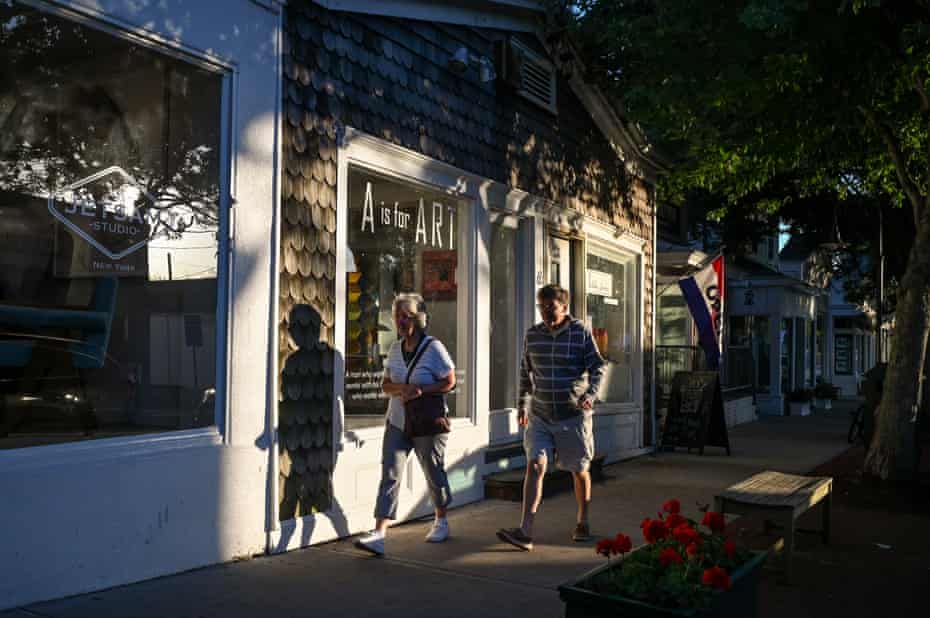Growing up in Southampton, Bryan McGowin spent his summers swimming in a beautiful local pond. Now in his 40s, McGowin won’t let his kids into the water.
“If you drink that now, you will get sick,” said McGowin. Across the New York coastal community better known as the Hamptons, residents face perilously declining water quality, which has shut down recreation in many freshwater ponds.
Today, the Hamptons are known as a playground for the rich and famous – but the region has had a sewage problem for decades. In the last year, the pandemic has pushed the region’s ageing sanitation infrastructure to a breaking point. The strain on the Hamptons’ resources has been exacerbated following the exodus of wealthy New Yorkers to their second homes in the area – dubbed “Black Friday” by locals.
The result has been a stunning amount of backups and spills, and the potential for long-term environmental damage as excess nitrogen – which leaches out more easily with older septic systems – seeps into the surrounding waterways and an underground aquifer that is used for drinking water.
“When people moved out here, they brought the entire family out here,” said Skip Norsic, who owns a third-generation trash removal and septic company.

Three times in the last year, Norsic says he’s been called to emergency backups, including one in which a homeowner noticed a sinkhole forming in their driveway, where part of the house’s septic system had collapsed. In the village business district, the situation is even worse. Norsic recalls one late-night call to a restaurant whose septic system was overflowing into the parking lot.
“The last thing you want to have is the smell of sewage in a restaurant where you are trying to eat your meal,” said the former Southampton mayor Mark Epley, who oversaw the village’s efforts in 2013 to create a centralized sewer system.
Although the Hamptons – which encompasses Southampton and East Hampton Town – are known as vacation spot for affluent New Yorkers, these towns have also been home to farmers and fishers, as well as Indigenous tribes like the Shinnecock, for generations.
But the fact that the village of Southampton never built a centralized sanitation system affects year-round residents and second-homers alike. Local officials estimate that Suffolk county – where Southampton is located – has more unsewered residences than any other similarly suburban county in the US.
Problems stem from the fact that a majority of homes in the surrounding watershed rely on antiquated septic technology. Nearly 75% of homes in Suffolk county rely on older septic systems that involve a cesspool a container in the ground which holds waste from the house. Cesspools are often made of brick or cast concrete, and can easily leach into the surrounding areas, making them an ecological ticking time-bomb. These older septic systems threaten the quality of groundwater long-term. And with the pandemic-related population surge (the leadership of Southampton projects that its year-round population grew from 60,000 to 80,000), continued use of these septic systems will only add more nitrogen into the surrounding waterways.

Already, drinking water in Suffolk county ranks in top 5% of nitrate levels in the United States, according to local scientists working on water quality initiatives. In 2019, a landmark study assessed nitrate levels in US drinking water and found that higher levels of nitrate exposure are associated with an increased risk of adverse birth outcomes – as well as an elevated risk for colorectal and other cancers.
The need for a sanitation system overhaul is acutely felt in the community around Lake Agawam – the most polluted pond in New York state – which happens to lie at the heart of Southampton Village.
Flanked by multimillion-dollar estates – some in the $20m range – Lake Agawam is plagued by annual toxic blue green algae, which stems in part from nitrogen pollution in the surrounding watershed. One expert estimates that if Southampton Village installed a central sewer district, total nitrogen inputs into Lake Agawam would decrease about 20%.
Although folks could swim and recreate in Lake Agawam for a large part of the 20th century, residents today are terrified of their pets drinking the water, let alone their families swimming or paddleboarding across the pond. In 2012, a dog died after drinking from a pond in East Hampton that was also experiencing blue green algae blooms, according to local reports.
“As you start to increase [population] density [while] using the same antiquated technology, what you have essentially is everyone’s wastewater is being discharged into the groundwater,” said Pete Topping, the head of Peconic Baykeeper, a non-profit organization dedicated to restoring Long Island’s waters.

Wealthy summer-home owners are not the only ones affected by Southampton’s sewage problem.
Last year, Lisa Votino lived in a garage apartment with her daughter, renting space from a family who typically only visited the home on weekends. At the start of the pandemic, the owners moved in full-time, and the house’s septic system went from supporting two people to seven.
Votino claims that a sewage incident that occurred a year later – when untreated wastewater flowed back into Votino’s bathroom through her shower drain – led to her eviction, a claim her former landlord disputes. “Lisa was not evicted,” her former landlord Frank Castellano says. “There was a septic problem. We needed to correct it.”
Votino says she and her daughter left after the bathroom overflowed, only to return the next day and discover their things had been packed and left outside. Castellano maintains Votino was always scheduled to move out, and that he offered her the ability to move back in April for a few weeks. But he did not deny the severity of the issue: “The bottom line is that these are problems out here now. Our infrastructure is not made for this.”
The Hamptons were never “meant to be lived in year-round”, says Votino, who no longer lives in Southampton. “Everything is being pushed to the max.”
In addition to the health risks for humans, the seeping wastewater overloads the area’s aquatic ecosystems with nitrogen, which is a disaster for marine life.
Suffolk county is surrounded by water, from Long Island Sound to the Atlantic Ocean to the federally recognized Peconic Bay estuary. The bay is a spawning ground for everything from blue crabs to oysters to American eels. In the 1980s, the estuary was the largest bay scallop fishery in the country.
Now, harvests of clams and scallops have decreased 99%, in large part due to the excess nitrogen from untreated groundwater, according to Christopher Gobler, head of coastal ecology and conservation at Stony Brook University’s marine sciences school.

“We are in a race against time because of climate change,” said Gobler. “As sea level rises, more and more septic systems will be closer to both groundwater and the bay, as the whole water table rises.”
This makes water contamination far more likely. Additionally, as temperatures rise, harmful algal blooms – which deplete the oxygen from water, creating zones that cannot sustain any marine life – will probably become more frequent.
In 2019, Suffolk county committed to investing $4bn over the next 50 years to eliminate cesspools and older septic systems. One of the challenges is that Southampton is the oldest English settlement in New York state, dating to 1640. It has many winding, crooked and narrow roads, which makes designing the village’s first-ever sewer district challenging.
The county is also offering rebates to homeowners who update their individual septic systems – but to date, only 773 have completed upgrades. More than 200,000 remain.
“There haven’t been scallops inside North Sea Harbor since the 1980s,” said McGowin, who was motivated by the declining water quality on Peconic estuary to start a septic upgrade company in Southampton. Today, he recalls scooping scallops from the eel grass there, saying, “I haven’t been able to do that since I was seven.”
-
The Guardian is partnering with Catherine Coleman Flowers, the award-winning sanitation researcher, to investigate sanitation shortfalls in the US. We’d like to hear from you if you face sanitation issues.